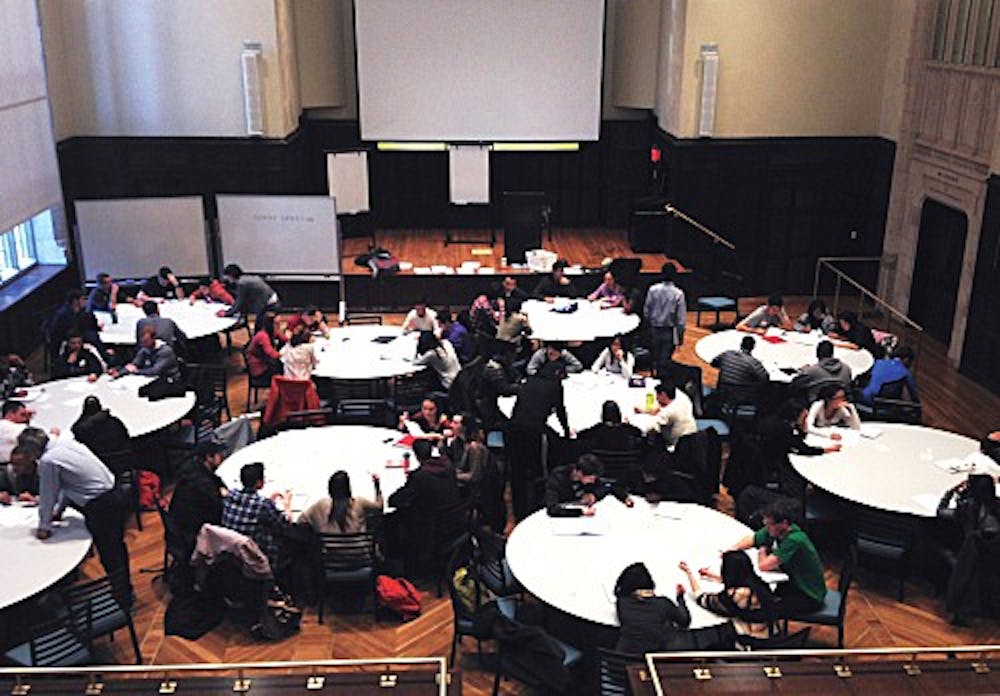
Students express mixed feelings with regards to active learning.
It’s Wednesday afternoon right after calculus class, and problem 10 on this week’s homework is really giving you a hard time. It would be great if the professor was right there to explain it — this is what Structured Active In-Class Learning intends to fix.
In these flipped classrooms, students are asked to familiarize themselves with material before class, while class time is used for working on practice problems under the guidance of professors and teaching assistants.
There are currently about 20 SAIL classes at Penn, ranging from science and math to humanities, and the amount only seems to be growing. The Vice Provost and the Center for Teaching and Learning have asked professors to submit proposals for new SAIL classes by Feb. 20.
Some students have expressed dissatisfaction with the active learning courses because they feel like they are basically teaching themselves. However, professors and the CTL continue to believe in the benefits of active learning classes.
“There’s a student complaint that you have to work hard in these courses, and you can’t get away with not working hard,” said Executive Director of the CTL Bruce Lenthall, who also advises the Vice Provost on educational initiatives. “Thinking about it holistically, a class that asks you to work hard and get a lot out of it is a positive thing. When you think about what you learned best, is it because someone told it to you or because you spent time working on it?”
Lenthall clearly notes, however, that there is a major difference between students being put in an environment where they are completely lost and have no guidance, and students being challenged, but given the tools to achieve.
“The CTL collects a lot of data from students about their experiences with the courses, about what works for them and what doesn’t and about their outcomes, and we try to share that with the faculty who are teaching the courses,” Lenthall said.
In addition, many faculty members meet together on a regular basis to discuss strategies for improving their courses, and the CTL provides support for TAs.
“This is how we learn. We learn from practice, we learn from making mistakes, we learn from talking,” said Economics professor Rebecca Stein.
Stein switched her popular Economics 001 to a SAIL class this semester. She was influenced both by numerous studies conducted about the effectiveness of active learning and by her own observations. Since 2010 she had used an opt-in, active learning style program for her class called Groups for Greater Applied Economic Thinking. Stein said although reviews for GREAT were mostly positive, students wanted more time to solve problems with guidance, which prompted the switch.
Stein is not the only one who has implemented active learning into her courses. Professor Nakia Rimmer has incorporated aspects of it into his Mathematics 114 course. While it is not a SAIL class, he has replaced weekly recitation quizzes with active learning worksheets.
“Having faculty members who can understand the problems and help students make connections with the challenges they’re having takes advantage of the faculty member and allows them to interact with the faculty member in a richer way,” Lenthall said.
Lenthall, Stein and Rimmer all pointed to studies that showed active learning has positive effects on student learning and grasp of concepts.
“These aren’t instant results. At Penn we’ve been doing this for two or three years,“ Lenthall said. “Just as if you take a brand new lecture course, the faculty member may improve it over the years, so I expect that all of these courses will improve over the years.”
The Daily Pennsylvanian is an independent, student-run newspaper. Please consider making a donation to support the coverage that shapes the University. Your generosity ensures a future of strong journalism at Penn.
DonatePlease note All comments are eligible for publication in The Daily Pennsylvanian.







